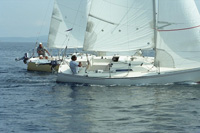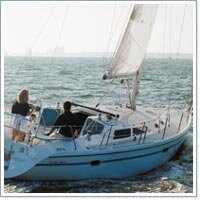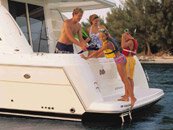By Stuart Walker
Golfers say, "Every stroke counts equally." Sailors say, "Every tack, and every jibe, and every tack or jibe continued, is either right or wrong." You cannot decide to sail in a given direction and then stop thinking; you must review your options—again and again.
There’s a difference between some tacks (or jibes) and others, and that difference is what makes sailing so much more difficult than golf. Sometimes the choice is obvious, in all Category I (oscillating shifts) conditions the correct tack is the lifted, and in many Category II conditions the advantage to one side of the course is obvious.
Sometimes the choice is not very important. For example, in Category III conditions (steady wind), clear air and tactical control are usually more important than the direction of the tack.
Sometimes, the choice is very important, but not obvious at all, when it comes to this third possibility. We ran into such a situation one fall day in the 2006 Soling Worlds on my home waters at Annapolis. The gradient wind was out of the west and at 3 p.m., as we started the second race of the day, was dying. But we could see that the Stars racing near Tolly Point to our south were sailing in a southwesterly sea breeze. This is what I call "two winds simultaneously."
We decided that the sea breeze would extend to our course and opted for a start at the port end. Just before the gun, the wind died dramatically and backed to the sea breeze, and we were able to cross the fleet on port and tack ahead and to windward, heading into the new wind.
I wanted to be on the lifted port tack, but the sea breeze was slipping away to the south. We had to keep tacking to starboard to stay in it. Then we noticed Peter Galloway, who’d started from the other end of the line, was leading a group that was lifting inside of us in a recrudescence of the westerly. As there was nothing but calm between us, we felt forced to ignore him and keep far enough left to stay in the erratic sea breeze. As we rounded the weather mark we were back in the westerly, a close sixth.
The wind became even lighter but those—including Bill Abbott—who opted for a high starboard jibe heading to the south of the fleet in the sea breeze seemed to gain most. But he stopped in the dead zone between the two winds and we rounded the leeward mark in a very light westerly ahead of him, still about sixth. Galloway had made a couple of excellent jibes and was now far ahead heading inshore and to the northwest on port in the westerly. The intervening boats, except for Tom Davies, followed him. I decided that the strongest wind was still the sea breeze and that this time it would take us all the way to the mark. I tacked to starboard and headed southwest.
The wind was stronger ahead and lured us onward. When Davies tacked to port about 300 yards from the mark, he had made a significant gain so we decided to cross his stern and get even farther left. He tacked back to starboard, and to get clear air, we bore away and attempted to sail through his lee. Then I looked astern and could see the leaders, far to the right, were on starboard, 20 degrees above our course, in a strong recrudescence of the westerly! We struggled to get back to the right and reach their wind, but it was too late. On a shortened course we finished 21st.
I shouldn’t have expected that at 3 p.m. in October (when the water is relatively warm) a Bay sea breeze would invade our course and lift a cool westerly from the surface. I could have expected it to happen near shore (where the Stars were sailing) perhaps, but not two miles offshore where we were sailing. This was not a classic Category II type of two winds simultaneously(TWS) in which a tack toward the sea breeze was essential—as it would have been at 1 p.m. in June when the cold marine air in the Bay sea breeze would have lifted the warm westerly from the surface and spread rapidly across the entire course.
Nor was it the variant of TWS in which two winds alternately occupy the entire course: a strong downslope or upslope wind that mixes with a gradient wind or a segmented parallel-to-shore flow with water on its left, for instance. Then because the thermal wind depends on the intermittent heating and separation of the overland airflow, it lifts the gradient wind from the surface intermittently, the two winds alternate at the water surface and the resultant shifts must be treated as oscillating. Jochen Schuemann won the 1997 Soling Europeans at Vilamoura, Portugal, in a parallel-to-shore easterly, whose segments replaced each other at about 40 minute intervals, by taking the lifted tack from every start and every leeward mark so as to be farthest toward the next 30-degree shift.
At Annapolis in October of 2006 a third type of "TWS" occurred. When the temperatures of the two winds are very similar, they have difficulty undermining one another and each wind is confined to its preferential portion of the course. In our case the gradient westerly persistently dominated the near shore portion of the course and the sea breeze dominated its western edge.
On the first beat Peter Galloway had tacked to port in the initial back of the westerly, had moved inshore of his rivals and, serendipitously, entered a near-shore zone of gradient westerly strengthened and veered by the inclusion of upper airflow (brought to the surface by thermal turbulence over the land). Determined to reach an area of increased velocity, we had ignored the shift and in a header (probably the farthest left direction of the sea breeze) had sailed away from the veered wind at the mark. (Mistake No. 1) Rarely—and certainly not in these circumstances—does finding more wind compensate for missing a shift in the opposite direction. And we had sailed away from the wind that was present at the weather mark, the wind that would ultimately determine the outcome of the leg (Mistake No. 2).
The important lesson is not that I could be wrong (I have been wrong before), but that such errors can be avoided. Prevention requires an open mind that is continually looking for evidence that the tack one is sailing is the correct one—rather then a closed mind that presumes that whatever tack was selected at the beginning of the leg should be continued to the layline.
I should have taken starboard tack away from the leeward mark only as far as a position from which I could see what was happening to the leading boats going right on port tack, and tacked. Then, if I could see that they had sailed into a header, I could have followed them until they tacked and tacked under them; and if I could see that they had sailed into a lift, I could have tacked immediately to get inside of them and nearer to that shift. The important issue in such TWS conditions is not on which tack to leave the mark—but recognizing you don’t know which tack is favored—and that you need more information. Look around!
In TWS situations in which one wind dominates one part of the course and another dominates the remainder and in most light air conditions (which usually means that a new wind is diminishing an initial wind, i.e., is due to TWS), the selection of the correct tack is extremely important, but not at all obvious. In these conditions you cannot know in advance which wind will dominate the area in which you must sail and particularly which wind will dominate the area around the windward mark; you must continually review your options.
Shared with Permission by Sailing World.


